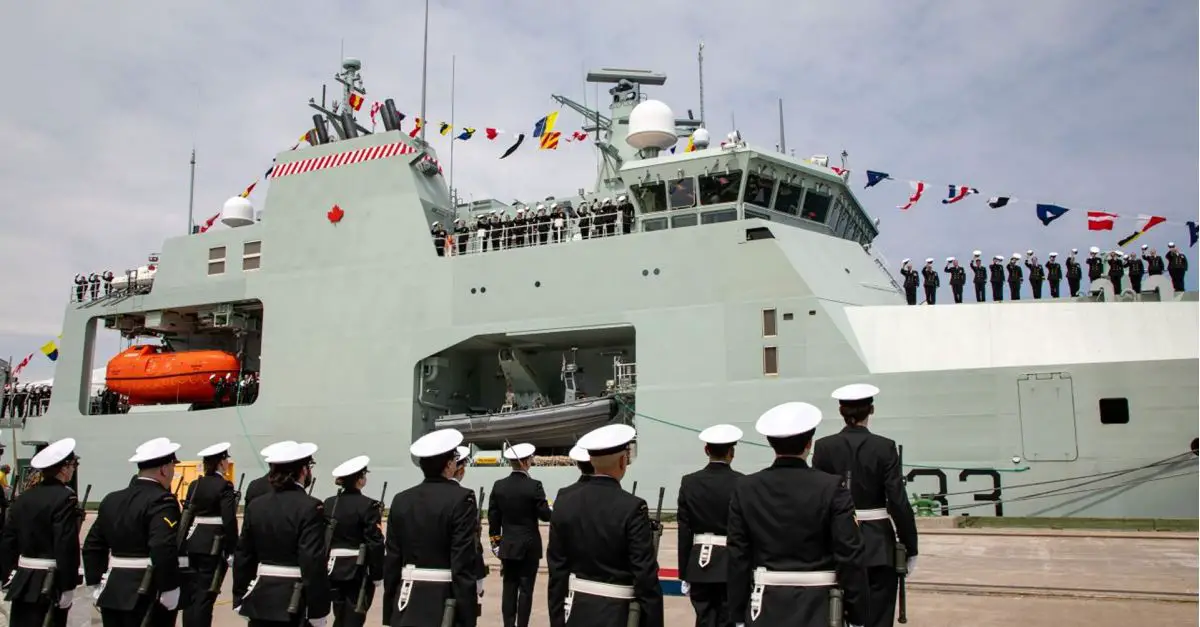Breaking news
Royal Canadian Navy Harry DeWolf class HMCS William Hall enters into service.
According to information published by Irving Shipbuilding on May 21, 2024, the Canadian shipyard holds commissionning ceremony of the Harry DeWolf class offshore patrol vessel HMCS William Hall.
Follow Army Recognition on Google News at this link

Commissionning ceremony of the Harry DeWolf class offshore patrol vessel HMCS William Hall. (Picture source: Irving Shipbuilding)
The program originated from the necessity to modernize Canada's naval capabilities, particularly in the Arctic, a region of growing strategic importance due to climate change and increasing international interest.
The program encompasses the design and construction of up to six Harry DeWolf-class ships. The first ship of the class, HMCS Harry DeWolf, was launched in September 2018 and commissioned in June 2021.
Technical data
The Harry DeWolf-class patrol ships, also known as the Arctic and Offshore Patrol Ships (AOPS), are ice-capable offshore patrol vessels commissioned by the Royal Canadian Navy and built by Irving Shipbuilding Inc. in Halifax, Nova Scotia. Named after Vice-Admiral Harry DeWolf, these vessels are designed to patrol and maintain sovereignty in Canada's Arctic region and support international operations.
With a length of 103.6 meters, a beam of 19.0 meters, and a draught of 7.0 meters, these ships have a full load displacement of approximately 6,615 tonnes. They are powered by two MAN 20V32/44CR four-stroke medium-speed diesel engines, each providing 4.5 MW, allowing speeds up to 17 knots in open water and a range of 6,800 nautical miles at 14 knots. The vessels can operate for up to 120 days without replenishment.
The Harry DeWolf-class patrol ships are classified under Polar Class 5, enabling them to navigate through medium first-year ice up to 1 meter thick, with a snow cover of up to 0.5 meters. For armament, they are equipped with a BAE Mk 38 Mod 2 25mm gun, remote-controlled .50 caliber machine guns, and various small arms.
These ships feature a flight deck and hangar capable of supporting the CH-148 Cyclone helicopter and can deploy unmanned aerial vehicles (UAVs) and other mission-specific equipment. The sensor suite includes the Thales NS100 dual-axis multi-beam surveillance radar, but they lack a dedicated sonar suite, reflecting their primary role in patrol and support rather than anti-submarine warfare.
The standard crew complement is 65 personnel, with additional capacity for up to 85 individuals, including mission-specific specialists and troops. For small boat operations, the ships are equipped with two multi-role rescue boats (MRRBs) capable of speeds up to 35 knots, used for boarding operations and search and rescue (SAR) missions.
The Harry DeWolf-class enhances the Canadian Navy's ability to operate in the Arctic and beyond, with primary missions including Arctic sovereignty patrols, search and rescue operations, humanitarian assistance, disaster relief, support for scientific research, environmental protection, and international engagements


























